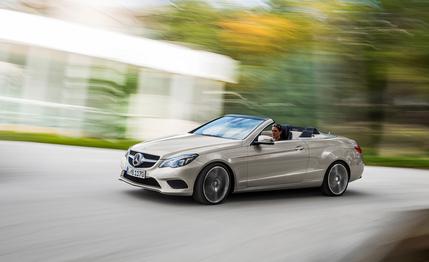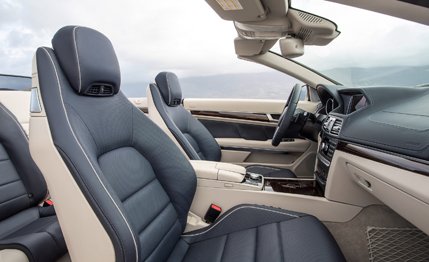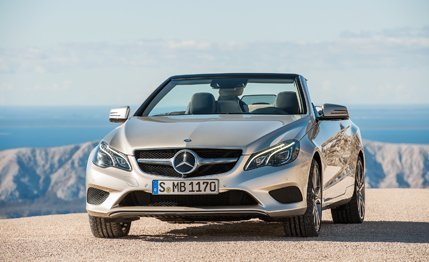
 First Drive Review
First Drive Review
Like its fixed-roof sister model, the Mercedes-Benz E-class cabriolet has been extensively restyled and updated for 2014. The changes are marked by upgraded driver-assistance systems and significantly altered styling: new headlights in a single housing, new taillights, a new grille, and new front and rear fascias. Unlike the 2014 E-class sedan and wagon, the two-door models keep their muscular rear haunches, an element that works better here than on the larger models. And for 2014, the E350 coupe and cabriolet use a carry-over naturally aspirated 3.5-liter V-6.
Now allow us to jump ahead to 2015, which will see the introduction of a twin-turbocharged V-6. Despite its 3.0-liter displacement, cars carrying the engine will be called E400—and if Mercedes’ badges don’t make sense, at least this engine actually makes more power than what’s under the hood of the E350. Although U.S.-market numbers are not yet finalized, we expect the blown six to produce 328 horsepower at 5500 rpm, up from the E350’s 302 horsepower at 6500 rpm. The torque difference is even more significant. Whereas the E350 produces 273 lb-ft at 3500 rpm, the E400 will make a far more substantial 354 lb-ft at 1400 rpm.
Mercedes is delaying the U.S. introduction of the twin-turbo 3.0-liter E400 to 2015 in order to feed the first cars to the red-hot Chinese market, where a 3.0-liter engine is incredibly important for tax reasons. And the simultaneous European launch is manageable, as Europeans prefer fuel-sipping four-cylinder engines and diesels.


We were able to drive the 2015 E400 cabriolet more than a year before its market launch and walked away impressed with the new engine’s character and capabilities. It emits a throaty sound on startup but is never intrusive, and power delivery is smooth and linear. Its estimated 0-to-60-mph time of 5.3 seconds is quick enough, being more than a full second fleeter than the E350 cabriolet’s. Top speed is governed at an easily attained 130 mph. Fuel consumption is rated at 31 mpg in the optimistic European cycle; real-life and EPA figures will be somewhat lower.
Similar to the pieces on other E-class models, the E400 cabriolet’s brakes and steering are uninvolving, but when not pushed to the limit—and these cruisers rarely are—the chassis is utterly pleasant and compliant. To help the car stay on the road, Mercedes has upgraded its many driver-assistance programs. Standard nanny systems include Attention Assist, which monitors the driver for signs of fatigue, and a collision-prevention system. Optional fare includes active cruise control that can make minor steering-wheel corrections as necessary, a lane-keeping monitor, cross-traffic alert, and precrash systems that prepare vehicle mechanisms in the event of an imminent rear collision or pedestrian impact.
Mercedes-Benz fits the E-class cabriolet with an electrically powered fabric top, not a folding hardtop. With its thick sound insulation, it reduces wind noise down to nearly coupe levels. Also, a spoiler rises from the windshield frame when the top is down, further reducing turbulence and the wind rush noise that would otherwise accompany it. The fabric is so tough it is said to be almost impossible to cut through it with a knife. When retracted, the softtop uses up far less trunk space than a folding hardtop would, leaving more room for luggage and such.


Competition for the Mercedes-Benz E400 cabriolet is thin; it includes the heavyweight Audi S5 cabriolet, the upcoming BMW 4-series convertible, and the relatively unsophisticated Infiniti G37 convertible (which adopts the Q60 badge for 2014). Elsewhere, the Lexus IS convertible is being phased out, and the Cadillac ATS convertible has been sacked at the behest of GM chairman and CEO Dan Akerson and his lofty profitability targets.
The E-class cabriolet has a lot going for it, including composure, style, and quality. If a V-6 is what you want, we advise that you wait for the 2015 E400, which has the far-more-responsive twin-turbo engine going for it compared with the outgoing E350. But as well as the V-6 performs, it maintains a respectful distance from the E550 with its powerful 402-hp V-8, which remains in the lineup for 2015 in coupe and cabriolet (but not sedan) form.